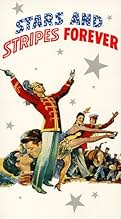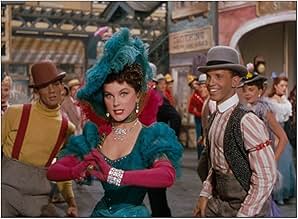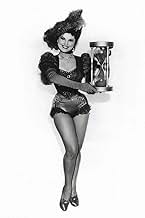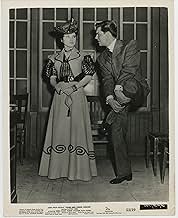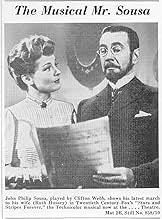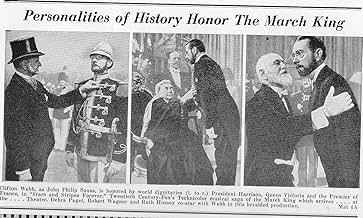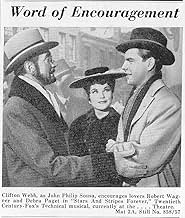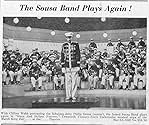NOTE IMDb
7,1/10
995
MA NOTE
Ajouter une intrigue dans votre langueA film biography of the composer John Philip Sousa, from his early days in the Marine Corps Band through the Spanish-American War in 1898.A film biography of the composer John Philip Sousa, from his early days in the Marine Corps Band through the Spanish-American War in 1898.A film biography of the composer John Philip Sousa, from his early days in the Marine Corps Band through the Spanish-American War in 1898.
- Récompenses
- 3 nominations au total
Thomas Browne Henry
- David Blakely
- (as Tom Browne Henry)
Frank Ferguson
- Mr. Wells
- (scènes coupées)
Aladdin
- Orchestra Conductor
- (non crédité)
- …
Bill Alcorn
- Specialty Dancer
- (non crédité)
Sharon Jan Altman
- Helen Sousa
- (non crédité)
Jon Andrews
- Minor Role
- (non crédité)
John Baer
- Chorus Boy at 'El Capitan' Rehearsal
- (non crédité)
Barbara Bailey
- Dancer
- (non crédité)
Patricia Barker
- Minor Role
- (non crédité)
Alvin Beam
- Minor Role
- (non crédité)
Bobker Ben Ali
- Reporter
- (non crédité)
Histoire
Le saviez-vous
- AnecdotesAccording to Paul Bierley's biography of John Philip Sousa, "John Philip Sousa, American Phenomenon", several musicians who had played under Sousa attended the world premiere of the film but walked out in disgust.
- GaffesIn the film the famous Sousaphone was invented by Willy Little. In actuality the first sousaphone was developed by James Welsh Pepper in 1893 at the request of John Philip Sousa.
- Citations
John Philip Sousa: What in the name of all get out's been keeping you so long?
Jennie Sousa: I was hearing the children's prayers.
John Philip Sousa: Does that take all night?
Jennie Sousa: They were praying for you.
- Crédits fousDuring the opening display of 20th Century Fox's logo, Sousa's "Semper Fidelis" was played instead of the usual 20th Century fanfare
- Versions alternativesSome releases include at the end a clip of the real John Philip Sousa leading the band in one of his famous marches.
- ConnexionsFeatured in Family Classics: Family Classics: Stars and Stripes Forever (1963)
- Bandes originalesSemper Fidelis
(uncredited)
Music by John Philip Sousa (1888)
Played during the opening credits
Also played by the Marine band at the presidential reception
Commentaire à la une
Having spent 6 years in orchestras and marching bands before graduating from high school, often playing Sousa's best known marches, I anticipated this partial biographical film. Clifton Webb does indeed come across as the real Sousa and certainly appears much younger than his 60+ years. He much reminds us of Frank Gilbreth in "Cheaper by the Dozen", another perfect role for him. The inclusion of the fabricated young couple played by Robert Wagner and Debra Paget was understandable, serving to lighten things up from time to time as contrasted to Sousa's rather starchy exterior. However, they come across as basically a '50s show biz couple interjected into an 1890s historical film. I was disappointed that more of Sousa's best known marches were not featured, nor the background of how he came to compose some of them revealed. After all, he did compose more than 100 marches, of which at least 8 should be recognized by every American as classics. In addition to "The Washington Post", "Semper Fidelis" and "The Stars and Stripes Forever" prominently featured in the film, "The Thunderer", "The Liberty Bell", "King Cotton", "El Capitan" and "The Corcoran Cadets March" should be instantly recognizable. In the film, we briefly see Sousa on a ship talking to himself about an idea for a classic march. But, we never find out that it is Christmas day, he is on a ship bound from Europe to America and is composing "The Stars and Stripes Forever" in his head. Also, it could have been brought out that his popular march "The Liberty Bell" was due to have quite a different name. However, after he saw a large backdrop of the Liberty Bell and coincidentally received a letter from his wife saying his son was marching in a parade honoring the Liberty Bell, he changed his mind. Sousa's opposition to recording his band and to radio broadcasts of his band could have been brought out(True, radio broadcasting had not been invented during the time period covered). Although he did allow many recordings of the Marine Band around 1890, he later became strongly opposed to recordings of his own band until very late in his career. In this resistance to new electronic technologies that allowed many unseen people to enjoy his music whenever they wished, he was in sympathy with Irving Berlin.
Sousa was not quite the one-dimensional genius popularly supposed. The film brings out to some extent his ambition to be a composer for the musical stage. He also composed several novels. The film could have also brought out the fact that Sousa was recognized as one of the top trap shooters in the world and initiated a national organization for trap shooters.
Sousa's name and origins were a subject for speculation. Several sources claimed that he was from various European countries and that Sousa was a stage name, the "usa" part representing "USA", his adopted country. Im fact, he was born and raised in Washington, D.C., his father being a member of the Marine Band. His ancestry is mostly Portuguese and Bavarian, Sousa being a rather common Portuguese and Spanish name. Variant spellings include d'Souza, Soza and Sosa.
One of film's highlights is the defiant appearance of his marching band in a southern city after notification that it's booking had been canceled due to popular opposition. I don't know if this incident has any factual basis, but Sousa's music and band are depicted as seen by many southerners as a purely Yankee institution. We see the faces of a group of African Americans when "The Battle Hymn of the Republic" is played, but I wonder what the reaction of the typical Caucasian southerner would have been. This inspirational Civil War favorite was in fact an unintentional collaboration between South Carolinian William Steffe, who composed the tune shortly before the Civil War, and unionist Julia Ward Howe, who provided the lyrics, one of various lyrics sung to this tune in both the North and South. Thus, it might have been interpreted as a unifying symbol.
Sousa was not quite the one-dimensional genius popularly supposed. The film brings out to some extent his ambition to be a composer for the musical stage. He also composed several novels. The film could have also brought out the fact that Sousa was recognized as one of the top trap shooters in the world and initiated a national organization for trap shooters.
Sousa's name and origins were a subject for speculation. Several sources claimed that he was from various European countries and that Sousa was a stage name, the "usa" part representing "USA", his adopted country. Im fact, he was born and raised in Washington, D.C., his father being a member of the Marine Band. His ancestry is mostly Portuguese and Bavarian, Sousa being a rather common Portuguese and Spanish name. Variant spellings include d'Souza, Soza and Sosa.
One of film's highlights is the defiant appearance of his marching band in a southern city after notification that it's booking had been canceled due to popular opposition. I don't know if this incident has any factual basis, but Sousa's music and band are depicted as seen by many southerners as a purely Yankee institution. We see the faces of a group of African Americans when "The Battle Hymn of the Republic" is played, but I wonder what the reaction of the typical Caucasian southerner would have been. This inspirational Civil War favorite was in fact an unintentional collaboration between South Carolinian William Steffe, who composed the tune shortly before the Civil War, and unionist Julia Ward Howe, who provided the lyrics, one of various lyrics sung to this tune in both the North and South. Thus, it might have been interpreted as a unifying symbol.
- weezeralfalfa
- 10 nov. 2007
- Permalien
Meilleurs choix
Connectez-vous pour évaluer et suivre la liste de favoris afin de recevoir des recommandations personnalisées
- How long is Stars and Stripes Forever?Alimenté par Alexa
Détails
- Date de sortie
- Pays d’origine
- Langue
- Aussi connu sous le nom de
- Stars and Stripes Forever
- Lieux de tournage
- Société de production
- Voir plus de crédits d'entreprise sur IMDbPro
- Durée1 heure 30 minutes
Contribuer à cette page
Suggérer une modification ou ajouter du contenu manquant

Lacune principale
By what name was La parade de la gloire (1952) officially released in India in English?
Répondre
